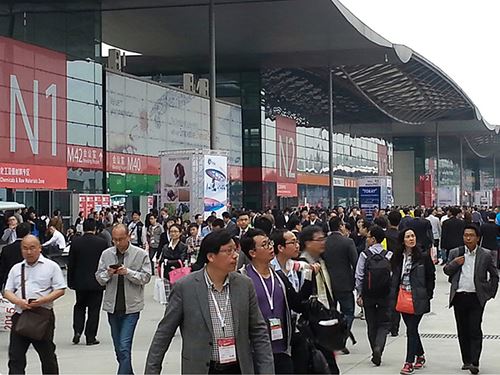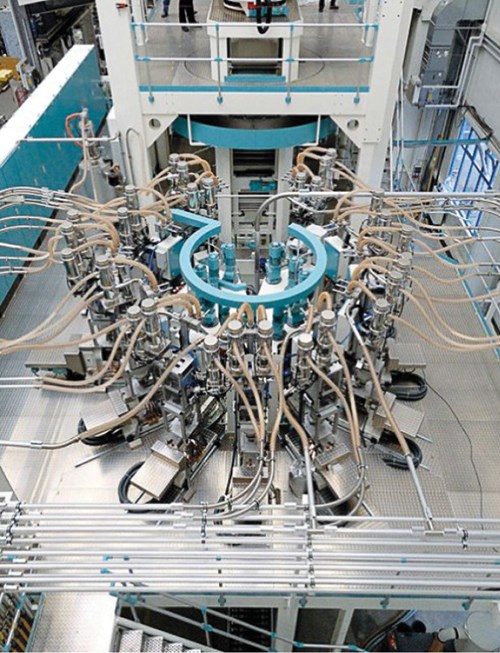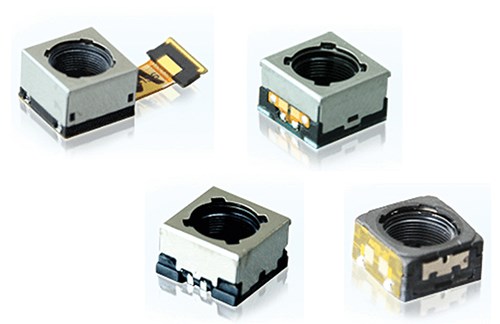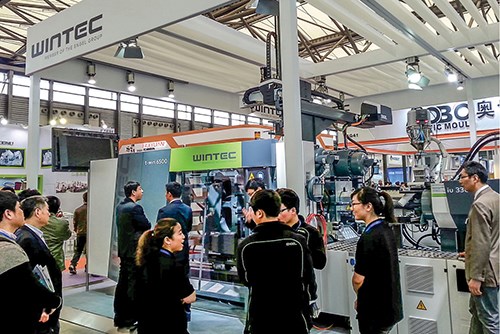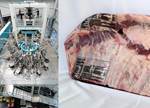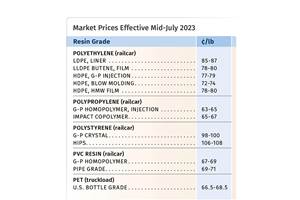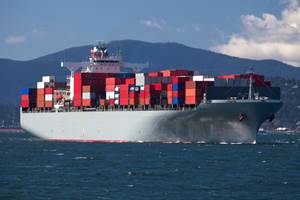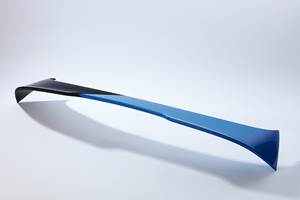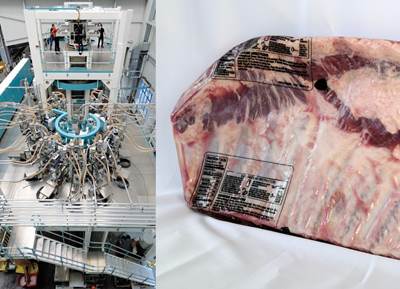Chinaplas Show Offers News For Packaging, Automotive, Electronics
Chinaplas
Fast-growing plastics fair showcases the region’s growing appetite for sophisticated food packaging, and more.
All the numbers bandied about with regards to China eventually come back to the same figure: 1.3 billion. That of course refers to the country’s population, and reflects the potential market for any given product. That massive opportunity has not been lost on resin suppliers, many of whom are now pushing advances for plastics food packaging while the eating habits of the most populous nation on earth are evolving.
As open-air markets and loose bulk foods give way to supermarkets and individually wrapped items, the size of China’s packaged food and beverage market has exploded. From 2008 to 2012, that sector grew by more than 76%, according to Euromonitor International. China is on pace to surpass America’s demand for packaged food and beverages in terms of volume by 2015.
Dow Chemical Co., Midland, Mich, sees China as only part of the broader demographic shift going on through all of Asia. Dow, which recently launched its Asia Pacific Pack Studio in Shanghai (one of four globally), noted that the middle class in Asia will reach 1.75 billion by 2020 and account for 40% of global middle-class consumption by 2030.
That region’s growing importance to packaging, automotive, and other markets was clearly reflected at the Chinaplas show in Shanghai in late April. And the fact that Dow chose the show to announce its new Asia-Pacific packaging development center reflects that event’s increasing importance. This year’s four-day show was the largest yet, with 130,370 attendees, 14% more than last year (when the show was held in Guangzhou). Chinaplas 2014 covered 230,000 m2 with more than 3000 exhibitors.
MORE LAYERS, MORE FUNCTIONALITY
DuPont, Wilmington, Del., showcased several multilayer film advances for food packaging that it says add functionality and reduce ecological footprint, primarily by cutting down on food waste. One was a new nine-layer barrier lidding film for sealing directly over APET food trays. It was developed together with Reifenhauser Kiefel Extrusion (U.S. office in Wichita, Kan.;). Reported benefits include improved seals, even in the presence of contamination, as well as cost reduction and higher gloss and clarity compared with the laminate structures currently used.
“We believe this is an important new technology,” notes Roger Kant, marketing director for DuPont Packaging & Industrial Polymers in Asia. “Right now it’s an embryonic technology. There are a few producers practicing it, and we are in close cooperation with equipment suppliers. I think over the next few years, this development will become particularly important for packaging.”
DuPont also discussed what it calls a high-performance, nine-layer barrier shrink bag, developed with German extrusion equipment supplier Kuhne Group. It reportedly combines a high shrink rate, good optics, puncture resistance, and softness.
Applications could include barrier shrink bags for fresh and chilled meat packaging, protecting product from the slaughter- house to the retailer. They could also be used in retail packaging of fresh meats and cheeses, providing a longer shelf life and better protection for items like bone-in meat.
“You need to understand how packaging is going to play out in the meat industry in Asia,” adds DuPont’s Kant, “both from a food-safety point of view and perspective of making sure that consumers get a quality product in hand. If you look in the stores here in China you can already see the signs that these are changing. Centrally packaged case-ready meat will be the future.”
Kant reported fast growth in the shrink bags, with more than 20 lines already up and running. Lidding films, however, remain under development. “The next step for multilayer lidding—to replace all the laminate structures with one multilayer film—will be challenging,” Kant admitted.
PACKAGING AS A BRAND PROTECTOR
Packaging was also on the mind of PolyOne, Avon Lake, Ohio, which launched its Precept authentication technology in Asia during Chinaplas. Mark Crist, v.p. Asia, notes that its anti-counterfeiting formulations and consulting “help customers protect product, maintain brand integrity, and grow market share without risk.” This announcement came on the heels of several very high-profile knock-off controversies in China, even as more brand owners source production in China.
“More companies today are choosing to manufacture high-end applications in Asia,” Crist says, citing potential Precept target areas like packaging for healthcare, premium foods, and consumer electronics. “With Precept, we are putting markers into the polymer structure so that we can identify whether that is in fact the packaging material that we provided to the customer,” Crist said.
PolyOne also used Chinaplas to launch OnCap Light Shield dual light-barrier additive for packaging that absorbs both ultraviolet and visible light to protect light-sensitive foods or pharmaceuticals from degradation in clear packages.
CLARIFIED PP POSITIONED FOR GROWTH
Milliken Chemical, Spartanburg, S.C.., used Chinaplas to announce a doubling of capacity for its Millad NX 8000 polypropylene clarifying agent, which is produced in Blacksburg, S.C. Cristina Acevedo, global product line manager for Milliken’s plastics additives, notes that the latest generation of clarifier has been adopted well in the market, thanks in part to less yellow tinge, greater solubility, and ability to process at lower temperatures. That last fact means a reduction in energy usage and cycle times.
NEW POLYOLEFIN CAPACITY TARGETS CHINA
Borouge, the Abu Dhabi–based polyolefin joint venture of Borealis and the Abu Dhabi National Oil Co., plans to bring an additional 9.9 billion lb of capacity on line in 2014, after tripling production in 2010. Laurence Jones, v.p. of marketing for film and fiber, says that food waste can be positively impacted by plastics. “We see a shift,” states Jones. “As people go from low to medium to high incomes, they buy more packaged foods. Major brand owners still predict double-digit growth due to the demographic shift.”
Borouge highlighted three materials for packaging: BorPure MB5568/5569 PE for short-neck beverage closures, Borstar RB707CF PP for blown-film, and Borstar FB 2230 PP for greenhouse films. BorPure for closures allows 10-15% downgauging with a 50% improvement in ESCR. Borstar blown-film PP allows 15% downgauging vs. current PE products, while Borstar in greenhouse films can enhance crop quality and yield by 8-11%, with up to 25% faster harvest speeds.
One theme ran throughout the advances, according to Jones. “You have to do more with less,” Jones states, noting all the grades allow for less resin to be used while actually improving performance and protecting the food so that its carbon footprint wasn’t created in vain. “Packaging integrity is most important aspect.”
CAMERA EXPLOSION FUELS LCP ADVANCES
Two years ago, Celanese, Dallas, introduced Vectra FIT70 liquid-crystal polymer (LCP) for compact camera modules (CCMs)—the tiny cameras found in everything from smart phones to tablets to cars—and as the market exploded, Celanese responded with a new offering.
Explaining how CCMs can currently be found in phones, medical devices, televisions, computers, and cars—letting drivers see what’s behind them as they reverse—Celanese’s Kevin Wu notes that two years ago, there was “zero” business in this area. Today, “It’s a very sizable market,” states Wu.
To support and advance the market, Celanese launched a new grade of Zenite LCP for CCMs, which features patent-pending antistatic technology that keeps the lens dust-free during molding, transport, and assembly. It also boasts better weld-line strength and abrasion resistance.
Celanese also made the Asian introduction of its next-generation PPS, Fortron ICE (improved crystallization evolution), which first launched at K 2013 in Dusseldorf. Fortron ICE can reach full crystallinity in injection molding faster and at lower temperatures than previous grades, allowing use of hot water instead of oil for mold-temperature control (see June Strategies for details).
Celanese’s Frank Zhang notes that in China many molders would have to upgrade their mold-temperature control technology to run a conventional PPS, but not with Fortron ICE. Lower temperatures mean faster cycles as well, with Zhang noting an average cycle-time improvement of 29%.
HOT RUNNERS FOR AUTOMOTIVE
With an eye towards the automotive market, Husky Injection Molding Systems, Bolton, Ont. (husky.ca), launched its new Unify hot-runner manifold system at Chinaplas, promoting the product’s one-step installation (see June Keeping Up). Craig Reynolds, Husky’s director of business development for hot runners and controllers, calls this a re-entry of sorts by Husky into the automotive space, after narrowing its focus recently to packaging and medical markets. At Chinaplas, Husky also announced the addition of the Altanium Matrix2 to its family of hot-runner temperature controllers, with control for two to 254 zones.
NEW BRAND, MACHINE AND STRATEGY FOR ASIA
Engel Austria (U.S. office in York, Pa.) is known as a high-end machine supplier, but the company is now launching a commodity brand, called Wintec, which will offer the t-win line of two-platen presses. “Wintec will focus on commodity applications, short delivery times, and high performance compared with Korean and Taiwanese competitors,” states Engel CEO Peter Neumann.
“In this new segment we are entering, we have standardized options,” Neumann continues. “That way we can offer a very competitive price for a high-end machine. We are entering a segment where we are competing against Asian machines and not against Western machines. The price-value relation has to show the customer that it’s worth it for him to invest in a high-technology machine,” adding that the customer will get “better quality, service, and performance.” Engel expects the machines to have a useful life of 15 to 20 yr.
Wintec will operate as a wholly owned subsidiary of Engel from a new production site in Changzhou. Annual machine capacity will be 300 units, with one shift and about 100 employees. The new site will have 17,000 m2 of production space. The factory sits on a 40,000 m2 plot, which could be extended to 48,000 m2.
The two-platen machines feature frictionless movement in the clamping zone, with zero contact between the tiebars and platens, which ride on linear guides. In terms of speed, the 1000-m.t. press boasts a dry-cycle time of 4.4 seconds. The servo-driven hydraulic machines with variable-volume pump will come in six clamp sizes from 450 to 1750 m.t. and three injection units. The very first t-win machines are currently running trials at customers.
Peter Auinger, president of Wintec and most recently working for Engel in Mexico, says the company will focus on three major application areas: appliance white goods, automotive, and large technical parts. Christoph Steger, Engel CSO, notes the machine is designed for the needs of commodity molders, and Engel plans to roll out the t-win in countries neighboring China and eventually in all of Asia. Company spokesmen emphasized that they do not plan to offer the machine elsewhere. At the show, Wintec ran a 650-m.t. press at its own booth in a separate hall from Engel, reinforcing the separation between the brands.
Related Content
PS Prices Plunge, Others Appear to Be Bottoming Out
PS prices to see significant drop, with some potential for a modest downward path for others.
Read MoreRecord Reshoring Rates in 2022
Reshoring and foreign direct investment (FDI) in the third quarter marked their highest ever level, eclipsing the previous record set in the second quarter of 2022.
Read MoreK 2022 Preview: Engineering Materials for Sustainability and E-Mobility
Materials that are sustainable yet offer equal performance to their fossil-based counterparts will be prominent at K 2022.
Read MoreAvantium and SCGC Partner to Scale-Up CO2- Based Polymers to Pilot Plant
SCGC will use Avantium’s Volta Technology which uses electrochemistry to convert CO2 to chemical building blocks such as glycolic acid which combined with lactic acid make carbon-negative PLGA.
Read MoreRead Next
DuPont Shows Off New Film Structures
DuPont Packaging & Industrial Polymers, Wilmington, Del., rolled out a series of packaging innovations at last month’s Interpack 2014 show in Dusseldorf, Germany.
Read MoreAdvanced Recycling: Beyond Pyrolysis
Consumer-product brand owners increasingly see advanced chemical recycling as a necessary complement to mechanical recycling if they are to meet ambitious goals for a circular economy in the next decade. Dozens of technology providers are developing new technologies to overcome the limitations of existing pyrolysis methods and to commercialize various alternative approaches to chemical recycling of plastics.
Read MoreTroubleshooting Screw and Barrel Wear in Extrusion
Extruder screws and barrels will wear over time. If you are seeing a reduction in specific rate and higher discharge temperatures, wear is the likely culprit.
Read More

